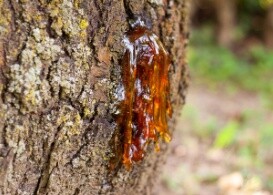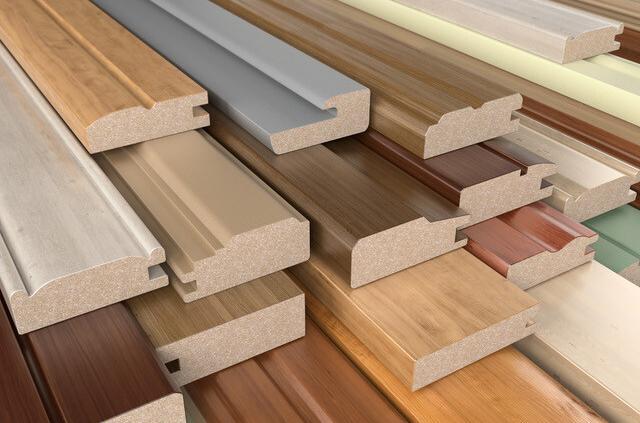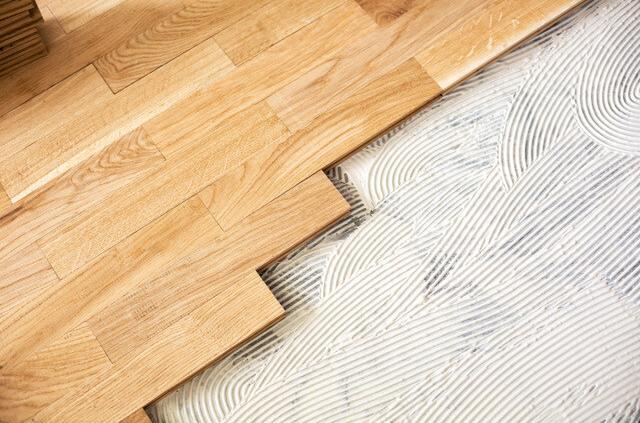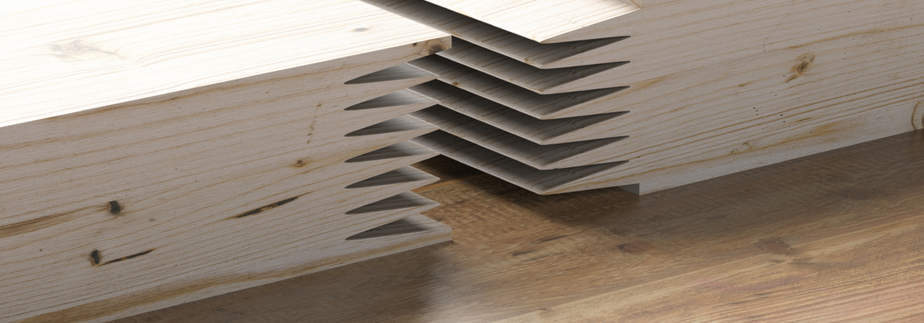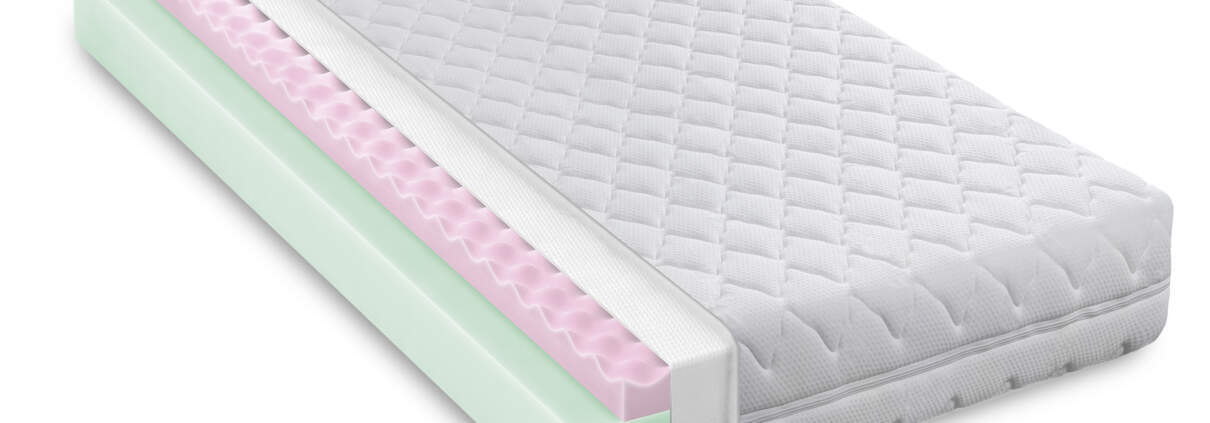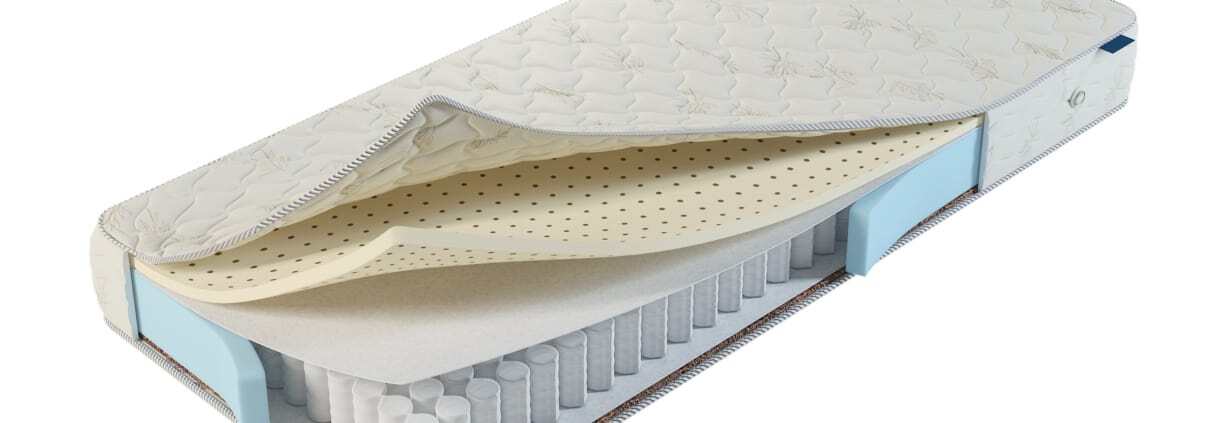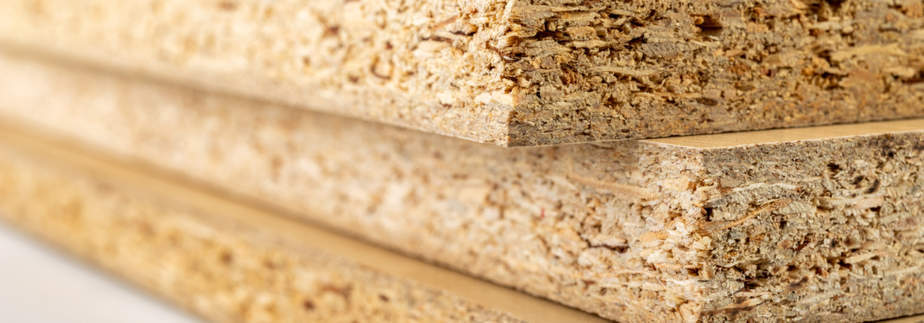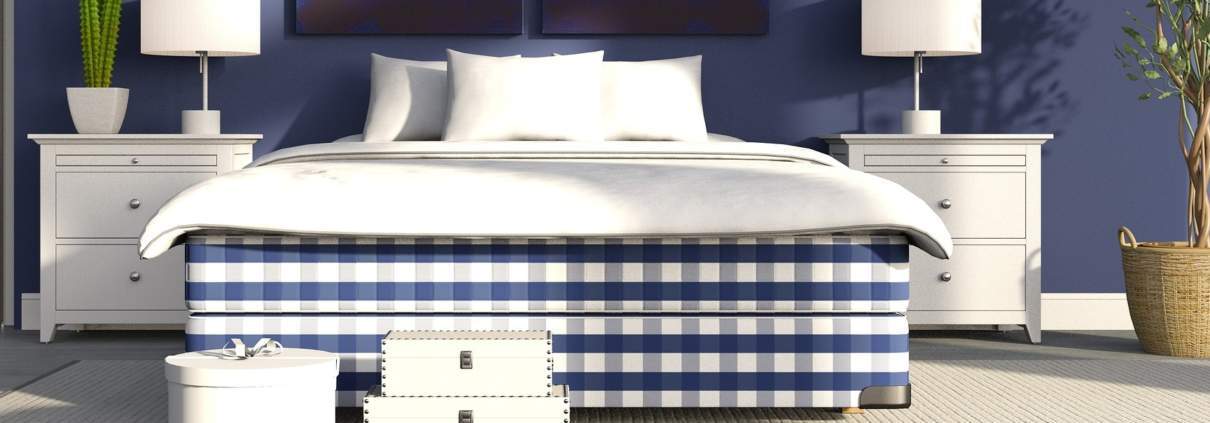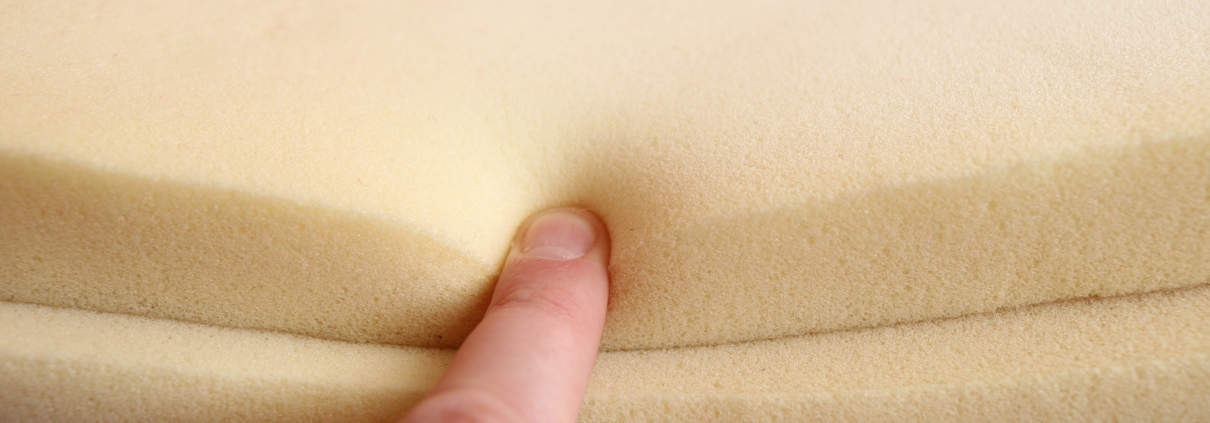The furniture industry makes use of a great number of bonds and seals realized with special adhesives and sealants.
Heat-resistant wood veneers and laminate adhesives
Hot-melt adhesives have long been highly valued for their versatility and strength. Those two qualities cannot be overemphasized—after all, there seem to be as many needs for adhesives as there are adhesives on the market. Of course, product performance can always be improved. While a one-size-fits-all, do-everything, universal adhesive might not quite be on the horizon, recent technological innovations include hot-melt glues that are effective with laminated paper and wrap profiles, are applicable for auxiliary furniture companies and their application machines, and, last but not least, won’t empty your bank account. Read on to learn more.
Qualities to look for in heat-resistant hot-melt adhesives
In spite of claims made in recent years about the end of office work and the so-called revolution of working from home, offices aren’t going away anytime soon—and neither is office furniture. Given looming overhead costs, often narrow profit margins, and the general pressure to survive in the business world, it is essential for office or auxiliary furniture to not only be of high quality, but also quickly and affordably produced. This goes for not only the materials you see on the outside, but also for the material that holds the office furniture (and thereby the office) together: glue.
The basics of hot-melt glues are straightforward. Pick your glue, heat it to the point of melting, and apply with your roller, nozzle or injector. As a hotmelt product, there is always a melting process before applying the glue on the paper foil, wood veneer, laminated product, or other material. Beyond those steps, finding the best fit for a hot-melt adhesive is a matter of which adhesive can withstand the highest temperatures of the melter and roller, while minimizing potential adhesive degradation loss, and whether the materials and surrounding climate make for optimal work conditions.
Auxiliary furniture companies can supply the parts, and wrapping machines can do the dirty work, but it really is the type of adhesive that “glues” everything together—literally. Wooden profile wrapping can be mismanaged if the adhesive used fails to have good bonding quality, with high temperature resistance, in order for the furniture to survive exposure temperatures that run as high as 80-90ºC when applying the adhesive. The above can be accomplished with more conventional adhesives such as EVA hotmelt and PUR hotmelt. EVA and PUR hotmelts, however, can be costly, PUR in particular, and there is no guarantee that EVA hot-melt adhesive will sustain an ideal high temperature resistance. Ideally, a buyer is able to strike a balance between price and quality, and an alternative with a better quality-price radio would be warmly welcome.
In spite of claims made in recent years about the end of office work and the so-called revolution of working from home, offices aren’t going away anytime soon—and neither is office furniture. Given looming overhead costs, often narrow profit margins, and the general pressure to survive in the business world, it is essential for office or auxiliary furniture to not only be of high quality, but also quickly and affordably produced. This goes for not only the materials you see on the outside, but also for the material that holds the office furniture (and thereby the office) together: glue.
The basics of hot-melt glues are straightforward. Pick your glue, heat it to the point of melting, and apply with your roller, nozzle or injector. As a hotmelt product, there is always a melting process before applying the glue on the paper foil, wood veneer, laminated product, or other material. Beyond those steps, finding the best fit for a hot-melt adhesive is a matter of which adhesive can withstand the highest temperatures of the melter and roller, while minimizing potential adhesive degradation loss, and whether the materials and surrounding climate make for optimal work conditions.
Auxiliary furniture companies can supply the parts, and wrapping machines can do the dirty work, but it really is the type of adhesive that “glues” everything together—literally. Wooden profile wrapping can be mismanaged if the adhesive used fails to have good bonding quality, with high temperature resistance, in order for the furniture to survive exposure temperatures that run as high as 80-90ºC when applying the adhesive. The above can be accomplished with more conventional adhesives such as EVA hotmelt and PUR hotmelt. EVA and PUR hotmelts, however, can be costly, PUR in particular, and there is no guarantee that EVA hot-melt adhesive will sustain an ideal high temperature resistance. Ideally, a buyer is able to strike a balance between price and quality, and an alternative with a better quality-price radio would be warmly welcome.
Innovations in laminate adhesive
APAO or Polyolefin hot-melt adhesive is a more recent innovation that can be both higher performance and lower cost in comparison with EVA and PUR. As a non-crystalline adhesive, APAO is flexible and with high initial tack, with a long setting time, making these adhesives ideal in product assembly situations with long open times and the aforementioned extraordinarily high heat resistance. In other words, not only is APAO adhesive adaptable to a vast array of
materials; APAO adhesive is also easily applicable via the various furniture-oriented profile-wrapping machines that are on the market. Furthermore, the better APAO adhesives out there can be stored for 2 years or longer, provided the product is stored under relatively cool conditions (between +5 and +35°), making them dependable long after initial purchase, whether you use it or not. Perhaps closer to the “bottom line” when making a decision is that, at least in comparison with PUR or polyurethane adhesive, an APAO adhesive is simply better priced. A quick check on the internet shows that APAO prices are consistently lower than PUR-based products.
A good, modern laminated paper adhesive does all of the above and more. High performance in terms of good bonding quality does not suffer at high exposure temperatures of 80-90ºC. And, versatility still matters more than we might think. Auxiliary furniture may seem vanilla, but there are so many materials used in the furniture industry that glues need to be developed to wrap profiles of chipboard, hardboard, light paper and melamine paper foils, MDF (medium-density fibreboard), polyester laminates, other fine-grained wood-based materials, or even solid wood. A good profile-wrapping hot melt successfully adheres to all of the above materials and more, and does so in medium high speed machines like Barberan and Duespohl that are equipped with applicators like Nordson, Robatech, or Metler. These are the benefits of APAO, in a nutshell.
With all this information, where to begin? Contact our experts and get guidance on finding the best solution for your furniture substrate bonding needs.
The first step to finding the right hot-melt adhesive is being informed about your options, and at least in that regard, this article should have you covered. But what then? Before your eyes glaze over from comparing hundreds of websites, cut through the advertising and misinformation on the internet and simply reach out to us. We can connect you to experienced vendors and users of APAO adhesives, who in turn can ensure that you work with an adhesive provider with comprehensive after-sales service, including technical support by phone, video call, or even in person, and in-lab quality control as needed. Speak with our representatives and get pointed in the right direction, today.
Elastic adhesives to glue for PVC, parquet and other floors
The range of adhesives for PVC, parquet, and other flooring options is wide and diverse. And, most industries don’t have limitless time or finances to try out every option on the market. However, recent developments in silane-modified polymers have led to new, much more versatile glueing solutions. Some of these high-quality adhesives for pre-finished materials go further, as they help establish more environmentally-friendly, low-emission qualities. Read on in order to better understand the choices available in the world of elastic adhesives.
A simpler, cleaner, stronger, more dependable adhesive for installation of wooden parquet
Choices for adhesives for flooring materials such as PVC and parquet isn’t something developers, manufacturers, and contractors should have to think twice about. After materials are chosen, laid down and glued together, a construction project should remain stable and safe. It should be obvious that flooring should not buckle or twist over time, and certainly, it should not come loose. Moreover, there should be no sense of human or environmental risk from the materials used.
Those risks increase as more variables enter the mix, however. Solvents, silicones, and isocyanates all can be inhaled, may have risks related to some diseases such as silicosis, lung cancer, kidney disease, COPD, asthma, gastrointestinal and respiratory tract irritation, and other carcinogentic concerns. Simply put, the materials used in flooring should not be a health risk. At the same time, a good adhesive for PVC and parquet flooring should remain elastic and strong long after curing, or the life of the adhesive will be unacceptably short.
Characteristics and qualities
Silane-based modified polymers manage such a balancing act. Ideal for PVC and wooden parquet installation, a single-component elastic adhesive can employ new technology to establish a high modulus of elasticity in the long term, while also establishing an extremely low VOC emission and being free of isocyanates and silicones. Such polymers that are free of solvents, certified by the French technological institute FCBA (L’Institut Technologique FCBA), can be at A+ glue emission class and exhibit top-level chemical resistance and adhesion.
Old product…new twist?
Whether it is a real estate, public works, or other project, and whether it is a matter of replacing parquet, rubber pavement, PVC, or some other type of pre-finished material, the aim remains to effectively glue materials together for long-lasting durability. Silane-based modified polymers cover all that and more, not only for PVC and parquet but also for lamparquet, planks, and solid wood. Moreover, as more modern radiant floors increase in popularity, demand for suitable adhesives for heated floor also increases. With their combination of durability and elasticity, a shelf life of 12 months, and a level of safety that merits not even needing a risk label, silane-based polymers are ideal for such a floor.
The work involved remains the same: take an industrial serrated spatula and apply the adhesive. And, just as with any adhesive, surfaces must be clean of dust, greases, oils, pollutants, oxides, and other contaminants that would lessen the adhesive quality. However, while the same can be said about, for example, polyurethane or water dispersion adhesives, only silane-based polymers achieve every aim described in this article. Only isocyanate- and silicon-free, silane-based polymers reach glue emission class A+, are free of solvents, achieve extraordinarily low VOC emissions, are a one-component MS elastic adhesive, and are suitable for parquet installation according to the EU’s EN 13489 standard for multi-layer parquet.
What to choose? Contact us to get expert help and the best solution for your industry’s needs.
Of course, specialist flooring distributors can have all the knowledge in the world about the characteristics of the ideal adhesive, but it won’t make a difference unless a developer or manufacturer knows which real-world industry market product is the best fit. Fortunately, some of the more advanced adhesive products available in today’s market offer a combination of being environmentally friendly, easy to apply, and long-lasting. They manage to keep a very low VOC emission. And, the very best can handle just about anything, including the growing market for radiant flooring.
Ideally, the product a contractor chooses is supported by a competent, experienced, easy-to-contact sales team willing to communicate online or in person, as needed. Some adhesive-oriented businesses even offer laboratory testing for different bonding materials. All the more reason to search for the best fit-not just the first fit.
Emulsion polymer isocyanate, EPI glue for wood
Emulsion polymer isocyanate, EPI glue is an efficient wood to wood adhesive which consists of two components. The first one is a water based emulsion, and the second one a hardener. The EPI glue formulations can vary as different emulsion and hardener combinations exist. In this article we will focus on a specific emulsion polymer isocyanate which has the benefit of being suitable for all types of wood, hard and soft. It is also suitable for wood with a high moisture content.
This specific EPI glue is suitable for example as a parquet adhesive, adhesive for finger joints and wood panels. The adhesive is also suitable for doors, windows, wood veneer and edge glued panels.
Benefits of EPI glue for wood
This EPI glue combines a water based emulsion adhesive with an isocyanate hardener. The combination comes with several benefits that make this specific glue a considerable choice for several wood to wood bonding applications.
- Suitable for all kinds of wood: this adhesive bonds all types of wood including hard and soft woods. Even bonding wood with higher moisture content is no problem. This allows for efficiency as one adhesive is suitable for numerous applications.
- Resistance: this EPI glue is resistant to heat, solvents and moisture, which broadens the range of possible applications and end uses.
- Energy saving: compared to similar adhesive systems, using this glue may result in energy saving as it is suitable for low to mid temperature press applications.
- Sustainable: this specific emulsion polymer isocyanate system is water based and does not contain formaldehyde which is classified as hazardous. The glue system has very low VOC content.
- Easy to export: as no hazardous chemicals are involved in this emulsion polymer isocyanate system, the adhesive and the products that use it are suitable for export without special arrangements.
- Long storage life: last but not least, the adhesive has a fairly long storage life compared to alternative systems. If properly stored, it stays good for a year, which allows for bulk purchase and possible savings in material costs.
Better than alternative wood to wood adhesives
The benefits outnumber some of the alternative wood to wood adhesive systems:
- UF – urea formaldehyde: adhesives that contain formaldehyde are very common and effective when bonding wood to wood. However, systems, such as EPI glue, that do not contain formaldehyde are much more user and environmentally friendly.
- PVA – polyvinyl acetate: PVA adhesives deliver great results in wood to wood bonding, nevertheless, emulsion polymer isocyanate adhesive helps achieve even better and stronger bonds.
Wood to wood adhesive bonding with EPI glue
Due to the numerous benefits that EPI glue brings along, the adhesive is suitable for multiple applications that involve different types of wood. The examples of possible uses include the following.
- Parquet: as a parquet adhesive, this glue bonds together the different layers during the manufacturing process of parquet.
- Wood panels: in wood panel bonding, emulsion polymer isocyanate technology can be used to bond different surface materials.
- Edge glued panels: as the name implies the edges of the panels are glued; EPI glue can be used for this application.
Note that the applications are not limited to the given examples. In case you are considering using EPI glue, contact us and get more information on the possibilities.
Standards to look at when opting for emulsion polymer isocyanate
When opting for an adhesive that uses emulsion polymer isocyanate technology, it is good to look at several standards. These include:
- CSN EN 14257: Adhesives – Wood adhesives – Determination of tensile strength of lap joints at elevated temperature (WATT ’91)
- EN-204: Classification of thermoplastic wood adhesives for non- structural applications
- ASTM D-5751-99: Wet use for laminate joints in non-structural lumber products
This specific system is certified according to EN 14257 and it meets the requirements of EN-204 class d4 which is the highest possible moisture resistance class. The adhesive is also suitable for lamination processes according to ASTM D-5751-99. Note that glulam and cross laminated timber that use this adhesive, can be approved only for non-structural use. In case you are looking for a laminating adhesive for structural timber, check out our article on the topic.
In need of a wood to wood adhesive?
In case you are looking for a wood to wood adhesive and considering using an EPI glue, do not hesitate to contact us. Our adhesive experts will extend your enquiry to a manufacturer with a proven track record in wood bonding. Not only do they provide the product, but you can also count on adhesives samples, material testing and technical support that guarantee the suitability of the adhesive for the specific needs of your project, product and process.
Waterborne adhesive for mattresses allows for sustainable mattress manufacturing
Lately the demand for waterborne adhesive for mattresses has been increasing as the manufacturing processes shift towards greener practices and raw materials. Waterborne adhesives are replacing their solvent based alternatives, as they do not contain any solvents, and so have very low to zero VOC (volatile organic compound) content.
Benefits of waterborne adhesive for mattresses
Next to offering a more environmentally friendly bonding solution than solventborne systems, water based mattress adhesives come with other benefits, too. These include:
- Fast application and curing: waterborne mattress adhesives are easy to handle and apply either by roller or spray. They are cured as the water evaporates either naturally or as a result of forced drying. Especially the water based spray adhesive systems can be used for automated mattress manufacturing.
- Tough and flexible bonds: water based bonds are tough and retain their flexibility. In many cases the bond is stronger than the foam layers it bonds.
- Safer working environment: as the water based adhesives for mattresses do not contain any solvents, no hazardous chemicals are released curing by evaporation.
- User-friendly products: the absence of solvents also ensures that the cured bonds do not release any possibly harmful fumes in finished products.
Changes in mattress industry affect waterborne adhesives
When waterborne adhesives for mattresses first were introduced, they only stood for a greener option compared to solvent containing systems. Today, waterborne adhesives for mattresses are just as good and durable as their alternatives, maybe even more advanced. There are several factors that have encouraged the intense development of these systems.
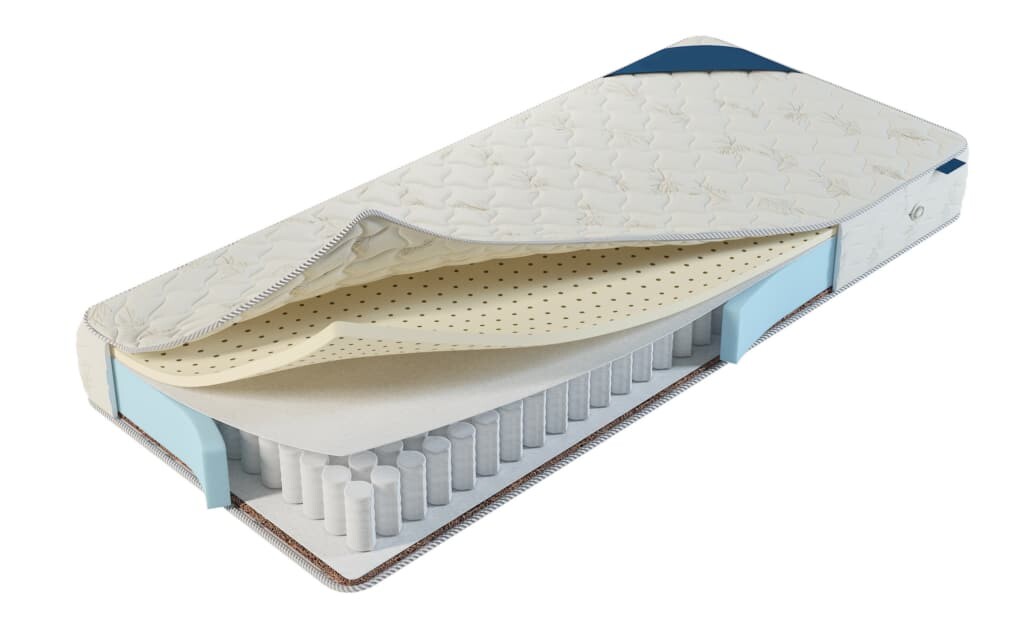
The mattress industry is shifting towards online sales, which increases the demand for just in time manufactured and delivered products as well as convenient and fast packaging. Water based mattress adhesives allow for fast curing bonds which remain flexible to enable roll packaging shortly after assembly.
Also the range of materials used for mattresses is becoming broader. Nowadays, customers choose for comfort and they are aware of the options. Therefore, materials such as gels and memory foams have been introduced to the mattress industry. Traditionally, these materials would be difficult to glue, but the development of waterborne adhesive systems enables even the trickiest materials to be bonded.
Water based adhesive innovations for the mattress industry
The success of water based mattress adhesives has not always been self-evident. The traditional waterborne solutions were not as strong as the alternatives, they required a long time to cure and still there was a chance of mold in the packaging due to insufficient evaporation. Since then waterborne adhesive for mattresses has come a long way. Now they are considered the most important adhesives for foam bonding in mattresses, next to hot melt glues.
Below we introduce some recent innovations that make the waterborne mattress adhesives an even better choice. Get now more information on the innovations by contacting us.
1. Plug and spray portable equipment
Developed especially for low volume adhesive consumers or large production facilities in need of a remote spray station, plug and spray equipment only requires compressed air to realize industrial adhesive applications. These low investment systems bring flexibility to the mattress production and make it possible for everyone to create industrial quality bonds. Next to the mattress industry, these spray systems are also applicable for example in the furniture industry when bonding upholstery.
2. Zero overspray installations for water based spray adhesive
Waterborne adhesive for mattresses can be applied by roller or spray. The spray applications tend to result in only 35% to 50% of the water based spray adhesive ending up on the substrate. The rest is overspray. Fortunately, new spray systems have been developed to reduce the overspray and achieve even 100% transfer efficiency meaning that no adhesive is wasted and material costs are decreased.
3. High assembly tack adhesives
High assembly tack adhesives have been introduced to the market as an economical yet high performance rollable water based adhesive. High tack assembly adhesives require up to 50% less adhesive compared to other rollable adhesives. This can lead to remarkable savings in material costs compared with other mattress adhesives.
4. CR free adhesives
One of the challenges the mattress industry is facing is scarcity and increased price of CR, polychloroprene, which is an important binder used in many waterborne adhesive systems. CR free adhesive systems have been recently developed to guarantee affordable and durable adhesives. The features of CR free adhesives imitate those of conventional polychloroprene adhesives but they use another binder.
For a manufacturer it is easy to make the switch to a CR free water based adhesive. All it takes is cleaning the existing line or spraying equipment.
5. Forced curing for extra speed
Waterborne adhesives for mattresses are often considered problematic due to the long drying time they require. In order to overcome the issue, systems that are suitable for forced curing have been developed. These adhesives are easy to apply and suitable for automated mattress manufacturing. The assembly line must include an integrated forced curing step, where infrared is applied to the surface causing immediate evaporation of the water. Thanks to forced curing, water based mattress adhesives can be applied and cured in a matter of minutes. The mattress can be rolled, packed and prepared for transport immediately without risking fungus problems in the packaging. The procedure allows for just in time production and saves the manufacturer storing costs.
In need of water based mattress adhesives?
Water based mattress adhesives exist as many different formulations. Therefore, one should always consider the production process, assembly line and desired features of the finished products before choosing a system. We at adhesives+coatings are happy to help you out and bring you in touch with the industry’s leading adhesive manufacturers. All you need to do is contact us through the button below.
Hot melt adhesives for mattresses enable non toxic bonding
Hot melt adhesives for mattresses are becoming increasingly popular, as they offer a non-toxic, environmentally-friendly solution for mattress bonding. These adhesives bond components together at the highest possible efficiency and at the lowest application costs. Different hot melt adhesive formulations are used for example for joining foam around springs, attaching cushioning foam and insulation to the mattress interior body and keeping upholstery fabrics and pillow top cushioning in place. All these applications are possible in an efficient manner with the lowest possible impact on the users and environment. All thanks to hot melt adhesives specially designed for mattresses.
Why choose for hot melt adhesives for mattresses
The reason for the popularity of hot melt adhesives for mattresses lays in the benefits the formulations provide. The most beneficial characteristics of hot melt adhesives for t he process and product include:
- Non-toxic: hot melt adhesives are 100% solid. This means that they do not contain any solvents, nor do they release toxic fumes. Their VOC (volatile organic compound) value is close to zero and they are non-flammable. This increases product and process safety also in the mattress industry.
- Fast curing: as the name implies, hot melt application uses heat to soften them to a liquid form. The adhesives cure as they cool down to room temperature allowing for quicker and easier assembly. Packaging is possible shortly after assembly.
- Production automation: to increase the assembly line efficiency and production, hot melt adhesives for mattresses are suitable for automated application processes.
- Easy to handle: in general, hot melt mattress adhesives are easy to handle. They come in a solid form, are fast and efficient to apply and, unlike water based systems, cure without evaporation. The use of hot melts increases the overall productivity.
- Colorfast: as mattresses are consumer products, the aesthetics play an important role. Hot melts are colorfast, usually white and absolutely non-yellowing.
- Strength: in many cases the fabric or foam which is bonded wears out earlier than the adhesive shows signs of deterioration.
- Costs: hot melt adhesives are generally cheaper than other mattress adhesives. When working with hot melts, less product is needed to make the same bond. There is also little to no overspray.
- Design freedom: hot melts adhere to a wide range of surfaces. This allows for using materials which usually would be difficult to glue. Materials such as memory foams and gels are no problem for mattress hot melts.
The down side of hot glue in mattresses
The only disadvantage of hot melt adhesive systems is that they may make a Velcro-like noise when the finished mattress is in use. This is due to faults in application: the bond is strong, but not uniform. Fortunately, new technologies allow for flawless application eliminating the problem of the mattress making noise. If the risk of noise is wished to be eliminated completely, other types of mattress adhesive could be considered.
Customized hot melt adhesive formulations with even more benefits
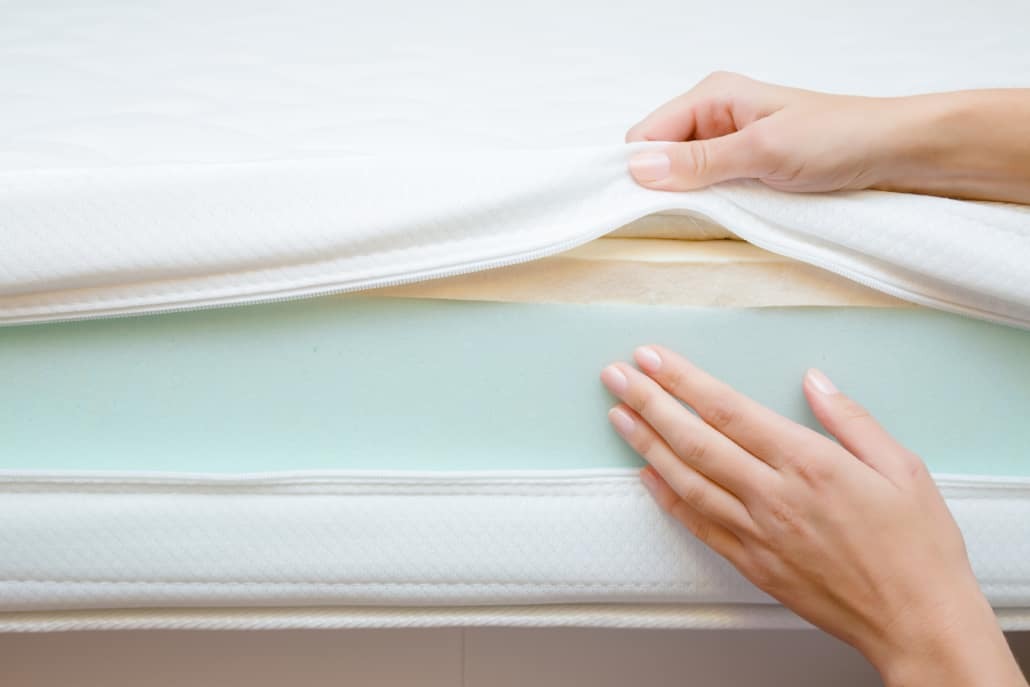
The hot melt adhesive formulations are continuously developing to meet the ever-advancing needs of customers in the bed market. Improved comfort is required and achieved through additional layers of gels and foams which also need bonding to keep the assembly together.
Most hot melt adhesives are modifiable. So they can perfectly fit the needs of your mattress production process, assembly line and the finished product. The modification takes place by additional plasticizers, tackifiers and waxes. In case you are looking for a hot melt adhesive for mattresses or are curious for the options, do not hesitate to contact us for more information.
Important specifications for mattress bonding
Hot melt adhesives for mattresses exist as different types and formulations which all have their unique characteristics. When defining the one that benefits your product and processes the most, it is good to look at some specifications of the different products. The most important factors to look at include the following.
- Melt viscosity (MV): melt viscosity measures the fluidity of the polymer in a certain temperature, usually at 190°C (375°F). The measure for MV is centipoise or cps. Very low viscosity allows for spray applications which are becoming the most common within the industry.
- Ring and ball softening point (RBSP): the RBSP identifies the heat resistance of the hot melt adhesive. The indicates at which temperature the hot melt material is soft enough to work with. In the mattress industry one must make sure the softening point is low enough so that the foams and fabrics do not get damaged or catch fire.
- Density: the density measure determines the hardness of the polymer. It also gives an indication to the strength of the cured bond.
- Open time: open time indicates the time how long the adhesive sticks after the curing process has started. Hot melt adhesives for mattresses can have opening time from 10 seconds to 4 minutes.
4 methods to apply hot melt adhesive
Bonding in the mattress industry requires adhesives that allow for foam to foam, foam to textile, textile to textile and coil to textile bonding. As the assembly line involves many bonding processes and different materials, there are several ways to apply hot melt adhesives which can help optimize the production.
- Pattern and swirl spray: the spray applications increase the surface area of the adhesive, which speeds up the curing time and boosts the efficiency. Spraying hot melt adhesives is also an economical application method, since it requires less adhesive to achieve strong bonds, which saves the manufacturer money. Note that the initial investment of spray equipment is rather high.
- Beads: bead applications result in a robust bond which provides the adhesive with the strength to hold a stressed mattress coil in place. When applying hot melts using beads, one should keep in mind the threshold for how much adhesive can be put down using this method.
- Gravure lamination: gravure lamination is a method common especially in textile bonding. The textile is rolled through a laminating machine in order to apply the adhesive. When applying hot melt adhesives for mattresses, it is necessary to heat the roll before running the textile through the machine.
- Webs: hot melt web adhesives are used for foam to textile applications. This method involves a heated nip or press which aids bonding the adhesive to the substrates.
Looking for the perfect hot melt solution?
Hot melt mattress adhesives exist as different types and they can be applied through various methods. Therefore, it is not always an easy job to choose for the hot melt formulation that provides your assembly line, process and product with the most benefits. Might you need any assistance in finding the perfect product, feel free to contact us!
New anchoring adhesive makes sustainable furniture
Many industries strive for sustainable, green solutions and reduced carbon footprint: furniture making is no exception. Therefore, the use of lighter and greener materials such as different wood based panels is ever increasing. However, the panels often have rather low density, which can make them weak. Fortunately, a new, one-of-a-kind reinforcement adhesive has been invented to solve the problem and make the lighter materials used in furniture making stronger. Reinforcing wood panels with the new anchoring adhesive brings along many benefits and opens unique opportunities to the industry as a whole.
Next to being the groundbreaking solutions for material weakness, the new anchoring adhesive for wood panel reinforcements is fast, strong and light: all properties that benefit the furniture making process and finished products.
4 ways to reinforce wood based panels with anchoring adhesive
As wood based panels tend to be rather light and have relatively low density, they may also be considered weak. The lowest density panels such as particle board can be reinforced as a whole but also higher density boards such as MDF and plywood can benefit from anchoring adhesive as local reinforcement which often carried out to enable fastener applications. All the furniture that is made of wood based panels such as closets, kitchen fittings, cupboards and shelves can benefit from this revolutionary reinforcement adhesive.
There are four ways the new anchoring adhesive can be applied when reinforcing wood based panels.
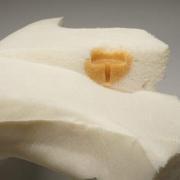
- Anchor for fastening points: the anchor adhesive can be injected into low density fiberboard or other wood panels locally, in order to create an adhesive anchor for fasteners. The adhesive flows into the material, penetrating it and curing in a matter of seconds. The fasteners can be placed immediately after applying the anchoring adhesive.
- Compaction of panel edges: also the edges of the particle board panels can be treated with this anchoring adhesive in order to increase profile machining and improve material resistance.
- In situ casting: casting of inner geometry can be done for positioning and fastening purposes.
- Reinforcement of complete panels: some wood based panels such as OSB (oriented strand board) are made using an adhesive to keep the wood particles together. This new anchoring adhesive can replace the originally used adhesive and result in a significantly lighter panel.
Note that this adhesive is new to the market and is likely to be suitable for many more applications also outside the furniture making industry: for example reinforcing honeycomb panels used in doors is possible. The anchoring adhesive can also be modified in terms of elasticity, adhesion profile and final strength. Do not hesitate to contact us if you think the properties of this adhesive suit your process and product!
New anchor adhesive brings long term benefits for furniture industry
As the furniture industry is shifting towards increased use of particle board, reinforcing the low density material becomes more and more important. Not only does the new and innovative anchoring adhesive make the board stronger, but it also provides long term advantages for the production.
- No adhesive waste: as the anchoring adhesive is applied by injecting it into the wood based panel, there is no adhesive waste. All the adhesive purchased, is also used.
- Proven application methods: the anchor adhesive can be applied automatically or manually. The injection applications are carried out using technology with a proven track record: even though the adhesive is new, the application technique is not. The application can be integrated into industrial, continuous processes in order to improve overall efficiency.
- Increased efficiency: thanks to the extremely fast curing of the adhesive, 2-4 seconds when injected, and the immediate readiness for drilling and milling, the cycle times can be kept short and the production efficiency is improved.
- Smaller carbon footprint: the reinforcement adhesive not only makes wood based panels stronger, but also allows for use of even lower density fiberboard: the reduction in chipboard density is possible up to 400 kg/m3. This leads to reduced use of wood, which reduces the environmental impact as well as enables lower material costs.
- Cheaper furniture: thanks to the reinforcement anchor adhesive, it is possible to reduce the costs of manufacturing wooden furniture. Due to the lighter weight, transportation costs also decrease. These together allow the furniture to be sold at lower price.
- Lower weight of furniture: next to reduced transportation costs, the reduced weight also makes it easier and safer to move around the furniture.
- Product quality and design possibilities: the use of this anchoring adhesive in low density fiberboard and other wood based panels increases product quality and extends lifespan as the material is made stronger in terms of higher pull out forces, and its moisture resistance is improved. Additionally, the reinforcement adhesive applications allow for greater design freedom and leave room for innovation.
The unique formulation of the new, revolutionary reinforcement and anchoring adhesive brings along several advantages which encourage the use of the adhesive also for other purposes than reinforcement and in other industries than furniture making such as automotive vehicle assembly and aerospace. Are you convinced this adhesive is what your process and products need? Contact us for more information and get connected with a supplier!
Take your furniture production to the next level with new reinforcement adhesive
The new, revolutionary reinforcement and anchoring adhesive system clearly aids the production of sustainable wooden furniture. In case you are interested in discovering the possibilities, contact us! Our experts are eager to introduce you to the supplier in our network.
The need for mattress adhesive is greater than ever
Mattress adhesive plays an important role in the mattress and bed making industry. The glue is responsible for keeping the different layers of mattresses together by bonding materials that are under the cover. Mattress adhesive can be used for instance for toppers, pocket spring and sandwich mattresses as well as open and closed cell foam mattresses, 7 zone mattresses and gel and memory foam mattresses.
The mattress and bed making industry is currently experiencing changes in regards of materials and material quality: more and more foams are used to make mattresses, and the need for efficient solutions is becoming paramount. Therefore, the mattress adhesives market is shifting towards more sustainable solutions such as hot melt glues and advanced water based adhesives. At the same time the requirements and need for mattress glue are greater than ever: the finished products must be long lasting, well ventilated, efficient to pack and transport as well as easy to clean and store without compensation on the quality.
Here you will find the different types of adhesives for mattresses, their advantages and disadvantages as well as application methods that make the process superior.
The right mattress glue boosts efficiency
Mattress adhesive brings along great advantages, not only due to its properties, but also the variety of possible application methods and equipment that can be customized to become an integral part of the production process. Once the adhesive application is integrated into the process, the overall efficiency improves regarding both cost and time in production, packaging, storing and transport.
The mattress adhesive application methods include rolling, spraying and beads. All these methods can be realized manually, semi automatically or automatically. For all these application methods to be optimal, proper implementation and training are required. Manufacturers of mattress adhesives provide products, suitable equipment and training to guarantee you the most efficiency.
New technologies allow for more and more efficient systems:
- Plug-and-play easy spray systems: an application process can be given a boost by using an easy to use spray system. These are often fully mobile and can be used in any location as long as compressed air connection is available. All you need to do is plug in the system and start spraying the mattress glue. Beds are ready remarkably faster when this method is used.
- Zero overspray systems: the development in transfer efficiency has resulted in zero overspray systems which represent 100% transfer efficiency. This means that all the adhesives for mattresses applied will be used, and none will be lost. These systems are enabled by the right combination of mattress adhesive and the right advanced application method.
- Immediately curing products: water based mattress adhesive systems that cure immediately, through forced curing process, remarkably improve process efficiency. The zero curing time allows for an uninterrupted flow of adhesive application, product processing and packaging. This allows for improved cost and time efficiency as well as controlled processes throughout the production without compromising to quality. This not only improves the mattress assembly process but thanks to this glue beds are generally produced faster.
The 3 types of adhesives for mattresses
Mattress adhesive is used in bonding foams, pocket coil assemblies, fabrics and fibers. It is crucial that the mattress glue is non-yellowing, durable, flexible as well as easy and fast to apply so that it does not affect the looks of the mattress, allows for transport and storing, and optimizes processes while resulting in long lasting products. The wished result can be achieved by one of three mattress adhesive systems which bond for example cotton, coconut fiber, foams and non woven materials.
1. Solvent based mattress glue solutions
The most traditional form of mattress adhesives are solvent based systems. These systems provide strong bonds, generally stronger than water based mattress glues. They can be applied by roll coating, spray or beads and dots.
The disadvantage of solvent born mattress adhesives is that they tend to release solvent fumes and adhesive residue in the air as they set when the solvent evaporates. Nevertheless, the new technologies allow for more user friendly systems where the share of solid parts is higher. This results in less solvent in the product as well as reduces the amount of product needed to complete the application.
2. Waterborne mattress adhesives
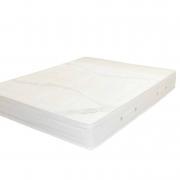
Water based adhesives are a step towards more sustainable bonding in the mattress industry. They do not form as strong bonds as their solvent based alternatives, but that is no problem, for a mattress adhesive does not necessarily need to be strong, as long as it is, and remains, flexible and odorless. Also these systems are applicable by spray, beads and dots as well as roll coating.
The great advantage of waterborne mattress adhesive is that it is environmentally friendly, releasing only water while setting by evaporation. The evaporation process, however, generally takes longer than when working with solvent containing products. If the longer setting time is not taken into consideration, the water may remain in the mattress and encourage mold forming once packed in plastic. Fortunately, the development of adhesive technology makes it possible to let the water based mattress adhesives cure faster and minimize overspray.
3. Hot melt mattress adhesive
The newest, and most efficient mattress adhesive on the market is hot melt which is applied with hot air and sets as the heat dissipates. Hot melt is the mattress glue with the fastest curing process and least risks as it involves neither solvents nor water thanks to its 100% solid consistency.
Hot melt glues have rapid initial tack which allows for more efficient processes and requires less mattress adhesives. The only downside of mattresses that use hot melt, is that they may make a cracking noise when the adhesive is dry. However, the continuous development and innovation are removing this disadvantage.
Hot melt adhesives for mattresses are usually applied as spray regardless whether they are a one or two component systems. There are also rollable formulations of hot melt mattress adhesives made possible by reducing the solid share to about 75%.
Standards and certificates for mattress adhesives
As durability, comfort and safety are key factors in mattress production and the finished products, many mattress adhesives are certified according to standards set by national and international standardization bodies. Below you can find examples of certificates relevant to mattress glues. These are recognized throughout the bed industry.
- TÜV Rheinland provides inspection services, testing and certifying to assess products and manufacturing processes regarding safety and sustainability.
- Eco Passport can be achieved for textiles when two stages of testing are done. The Stage I Eco Passport tests are run according to OEKO-TEX® Restricted Substances List and Manufacturing Restricted Substances List. Stage II includes analytical verification of products in OEKO-TEX® laboratories. The Eco Passport means that the mattress adhesive is suitable for use in sustainable production of human ecologically optimized textiles.
- GB18583-2008 is the Chinese standard for Indoor Decorating and Refurbishing Materials – Limit of Harmful Substances of Adhesives. Testing according to the Chinese standard is especially relevant for products that are targeted to the Asian market.
- GREENGUARD Gold Certified ® offers criteria for safety factors, rather strict by nature. The factors assess the product´s safety regarding sensitive individuals such as children and elderly. The certification also insures that the products are safe to use in environments such as schools and healthcare establishments. It is referenced by both The Collaborative for High Performance Schools (CHPS) and the Leadership in Energy and Environmental Design (LEED) Building Rating System.
Find the right adhesives for mattresses and improve efficiency
If you are in need of a durable and efficient adhesives for mattresses, do not hesitate to contact us. Your enquiry with us will end up to our mattress adhesive specialists who are happy to assist you in finding the right system and application method as well as making mattress adhesives application an integral part of your production process. Get in touch, and maximize efficiency.
Gluing foam with foam bonding adhesives
Many industries deal with foam bonding as a part of manufacturing and construction processes. Foam bonding refers to forming bonds between multiple foams or foams and other materials. This is realized by applying foam bonding adhesives or glues which create bonds foam to foam or foam to other materials such as metals, plastics, wood and fabric.
Industries, where foam bonding adhesives are applied include for instance upholstery in furniture making, mattress and pillow manufacturing as well as seating in vehicle manufacturing. In this article we will take a closer look at the different types of foam adhesive as well as the foam processing applications they make possible.
Different types of foam adhesive systems
Every foam processing application is unique and requires a specific foam bonding adhesive. The choice of what adhesive to use for foam should be based on the product requirements, the application method and the overall process. Foam glue can remarkably improve efficiency when the right combination of these factors is found. The foam adhesives are suitable for batch, unit and mass production.
Here the types of foam bonding adhesives are introduced based on the different chemistries enabling them.
Water based adhesive for foam
Description: Water based adhesives are free of solvents and cure when the water evaporates. The curing process can also be forced leading to instant setting, making the application even faster and the overall process controllable. Fast curing water based adhesive for foam is especially beneficial for the mattress industry as it is safe and user friendly as well as allowing for increased production efficiency.
Application: The water based systems are versatile in terms of application methods: the most common method is spraying, but others such as beads and roll coating are possible in foam bonding applications. Water based foam glue is effective also as an adhesive for foam to foam.
Advantages: As these systems do not contain solvents, they are eco and user friendly releasing no odors at all. Therefore, they are suitable for example for applications in the mattress industry. They form bonds which may not be the greatest in strength, but more than suffice in flexibility. This type of flexible glue for foam is required for example in furniture upholstery.
Disadvantages: Compared to alternative systems, waterborne adhesives normally cure rather slowly due to the speed of water evaporation. There is also a possibility of water remaining in the product and resulting into mold during storing. However, new technologies allow for faster, even immediately, curing foam adhesive products where the aforementioned risks are reduced to minimum.
Solvent based foam adhesive
Description: Systems based on solvents are strong foam bonding adhesives that use solvent as the carrying agent. These adhesives set when the solvent evaporates. Solvent based systems are common as both foam to foam adhesive and foam to other materials glue.
Application: Solvent based foam adhesives can be applied by roll coating, spraying or beads and dots.
Advantages: Where strength is required of the bond, a solvent based foam bonding adhesive is at its best. Newer solvent based, high solids adhesives are efficient by requiring less product for forming bonds. Due to the higher solid share, these foam adhesives contain less solvent, which makes them more environemntally and user friendly.
Disadvantages: Solvent based products generally have a reputation of being harmful for the environment. This is due to the curing process during which solvent fumes and adhesive residue come free requiring the applicators to wear protective clothing and masks. The risk for air contamination is lower when using products with high solid share.
Hot melt adhesive for foam bonding
Description: Hot melt adhesive is the new comer among foam bonding adhesives. These 100% solid adhesives are applied using heat and they cure when the heat dissipates. Hot melts are especially popular in the bonding foam in mattresses.
Application: Hot melt glue is almost predominantly applied by spray unless the solid share is reduced to about 75% allowing for a liquid state of matter. The liquidized hot melt foam adhesives can be rolled onto the substrate.
Advantages: The 100% solid hot melt adhesives bond foam to various substrates without involving any solvents: they are also an excellent adhesive for foam to foam bonding. The hot melt adhesive for foam also enables efficient application methods, cures fast and saves time and money.
Disadvantages: One disadvantage associated with hot melt products is that, while being a very flexible glue for foam, they may make cracking noises when being bent or otherwise moved. Technologies have been developed to eliminate the problem especially for the markets, where this matters: mattresses and furniture.
Beneficial characteristics of foam bonding adhesive
Depending on whether the foam glue is applied to insulating foam, upholstery foam or other foams, there are a number of characteristics that make the adhesives suitable. These include:
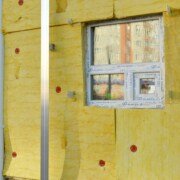
- Non yellowing: where the visual aspects play an important role, it is paramount that the foam adhesive does not start yellowing when time passes, but retains its original color.
Example: adhesives for upholstery in furniture making. - Flexible: in many cases the foam is flexible, meaning that also the foam bonding adhesive must adapt to the foam’s movements without cracking.
Example: upholstery and mattress foam bonding systems. - Heat resistant: some foam bonding glues are used for bonding acoustically or thermally insulating foam. These foam adhesives come into contact with heat that must not affect its adhesive properties.
Example: glues for polyurethane foam used for heat insulation. - User friendly: foam bonding adhesives are applied to products that are in everyday use, also in environments where safety is crucial. In those cases absolute user friendliness is required of the adhesives.
Example: adhesives and glues used in pillows, other foam processing applications for environments such as schools and hospitals.
Foam bonding adhesives can additionally have properties which are beneficial for the application process. These include the following:
- Long open times: when the foam glue is applied to the substrate, it does not start curing immediately, leaving time to properly position the substrates to be bonded.
- Instant curing: for some foam bonding applications it is crucial that the adhesive cures immediately and can be further processed and packaged without interruption.
- Economical in use: many foam bonding adhesives are economic in use, yet some can even be applied with zero over spray meaning that none of the product is lost. Zero overspray systems are a result of the right combination of foam adhesive, application method and equipment.
For more information about the different properties and products, please contact us. Our specialists are happy to assist you deciding what adhesive to use for foam in order to improve your process and products.
Foam glue standards and certification
Foam bonding is a part of many industrial production processes resulting in goods meant for various environments. Some products must be certified according to national or international standards, to show their suitability for these environments. Here some of the relevant certificates are introduced.
- TÜV Rheinland provides inspection services, testing and certifying to assess products and manufacturing processes regarding safety and sustainability.
- GREENGUARD Gold Certified ® offers strict criteria for safety factors, that assess the product´s safety regarding sensitive individuals such as children and elderly. The certification insures that the products are safe to use in environments such as schools and healthcare establishments.
- Eco Passport can be achieved for textiles. It guarantees that no OEKO-TEX® restricted substances are used in the products or manufacturing process and they are suitable for use in sustainable production of human ecologically optimized textiles.
- GB18583-2008 is the Chinese standard for Indoor Decorating and Refurbishing Materials – Limit of Harmful Substances of Adhesives.
Find the best foam adhesive system for your project
The combination of foam bonding adhesive, application method and efficient processing are the key to successful foam converting. Our specialists are happy to assist you determining what adhesive to use for foam in your project. You can also get help in choosing the application method as well as implementing foam bonding to your production process. All you need to do is contact us for more information.
Furniture adhesive for safety and sustainability
The furniture industry makes use of a great deal of adhesives which improve the production process and guarantee safety and suitability of the finished products. Furniture adhesive systems are used for creating bonds between fabrics, foams, wood, metals and plastics. As the variety of adhesives and application within the furniture industry is wide, this article focuses on adhesives used for bonding soft furniture and furniture upholstery including furniture for schools, hospitals, offices and airports as well as seats in vehicles such as trains and airplanes.
Beneficial properties of furniture adhesives
In soft furniture and furniture upholstery the task of the adhesive is to keep the furniture foam in place much like in the mattress industry. During the application it is crucial that the furniture glues do not penetrate the pores of the substrate but rather remain on the surface enabling strong bonds with other materials without affecting the properties of the substrates. Additionally the adhesive must be able to absorb great tension right after being applied. Most importantly, the right adhesive can improves overall efficiency by being fast and easy to apply.
Next to the properties required during the application, there are a number of characteristics a furniture adhesive should have, in order to support the quality of the finished products. These include:
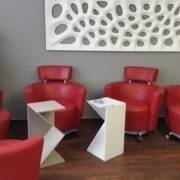
- Elasticity: as upholstery and soft furniture involve adhesives for soft and flexible surfaces, also the adhesive must remain elastic and not break due to movement of the material.
- Invisibility / non-yellowing: the purpose of furniture adhesives is to bond materials together unnoticeably. Therefore, it is crucial that the systems retain their original color and do not turn yellow when the bonds get older.
- Eco-friendliness: in the furniture manufacturing, sustainability is becoming more and more important. Therefore, also the products used during the process must contribute to reduced risk of environmental contamination.
- Chemical resistance: furniture used in public areas, institutions and vehicles should be resistant to chemicals so that even intensive cleaning and aggressive substances do not affect them. Therefore, the adhesives must not be affected either.
- Durability: the most important reason to use furniture glues is the durability and long life span they give to the products.
Bonding for furniture upholstery and soft furniture
Traditionally the furniture industry made use of solvent based strong adhesives. However, for decades the trend has been towards environmentally and user friendly products. Therefore, the most used furniture adhesives nowadays are either water based dispersion adhesives or hot melt glues.
- Waterborne dispersion adhesives: water based adhesives for furniture industry are environmentally friendly and solvent free. They cure by evaporation as the water in them leaves the system. The curing process can also be forced, which results in immediate curing saving time and making the process more controllable. They can be applied by spray, roll coating or beads and dots. Spray applications are by far the most common.
- Hot melt furniture adhesives: hot melt glues are thermoplastics which are applied without using water or solvents. These systems are applied using heat and they cure as they cool down. Solvent free hot melt systems for furniture are applied predominantly by spray.
Note that some adhesives can be given additional properties or the existing ones can be enhanced by modifying the product with a solvent based solutions. These solutions can for instance make the bond stronger, increase the adhesive´s heat resistance and enhance the extent of water resistance of polyurethane adhesives. The possibilities to modify the furniture bonding solutions are becoming more and more important, since the demand for furniture is growing.
Certification of furniture glues products
Sustainability and safety as well as suitability for specific applications are of high importance for furniture and furniture adhesives. Along with these factors come the relevant certificates. Below you can find some examples of certificates that benefit furniture adhesives.
- Eco Passport can be achieved for textiles in the furniture market. It guarantees that no OEKO-TEX® restricted substances are used in the products or manufacturing, and they are suitable for use in sustainable production of human ecologically optimized textiles.
- TÜV Rheinland provides inspection services, testing and certifying to assess products and manufacturing processes regarding safety and sustainability.
- GREENGUARD Gold Certified ® offers strict criteria for safety factors that assess the product´s safety regarding sensitive individuals such as children and elderly. The certification insures that the furnitures is safe to use in environments such as schools and healthcare facilities.
- GB18583-2008 is the Chinese standard for Indoor Decorating and Refurbishing Materials – Limit of Harmful Substances of Adhesives. This standard is especially relevant for furniture adhesives used in goods targeted at the Asian market.
Assistance & advice for finding the ideal furniture adhesive
Finding the right adhesive for furniture upholstery and soft furniture may be challenging due to the different types of foam materials that require bonding, and the complete production processes that should be made as efficient as possible. In case you require any additional information, advice on products or application, or training in furniture adhesives, do not hesitate to contact us. Our specialists are here to help you out!

